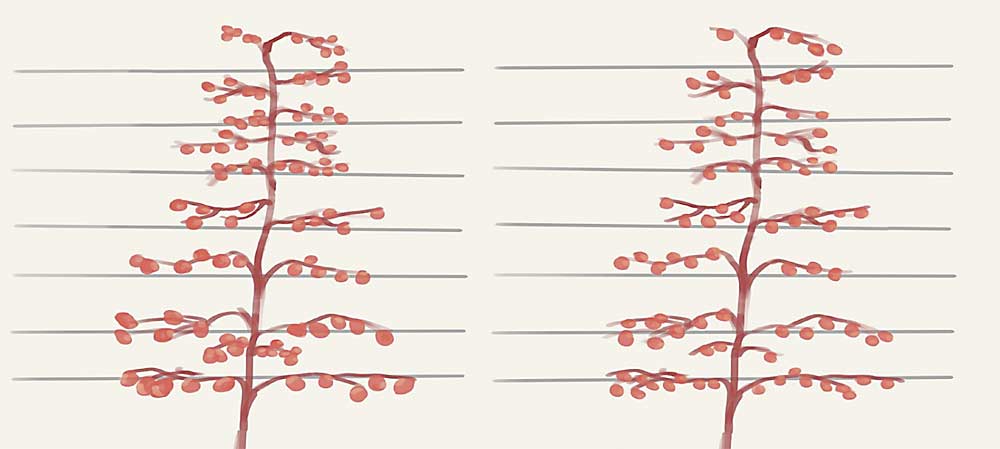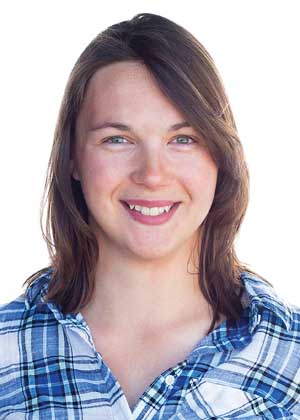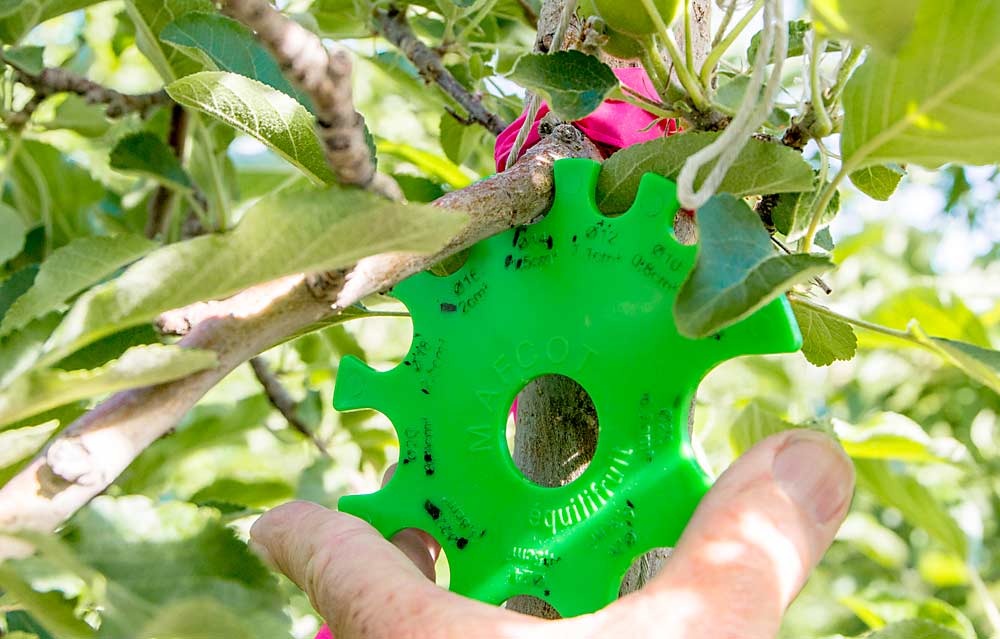
If you’re an apple grower, you’ve probably agonized over thinning decisions. When should you thin? With what? And how much?
Once you’ve made those decisions, more angst awaits. Did the chemical thinning work? How well?
You might not get those answers before you have to make the next decision, so you end up spraying again just to be sure. By green-fruit time, you realize you didn’t thin enough, and now you have to thin by hand — which almost always takes longer and costs more than you would like.
Ken Breen, a tree fruit physiologist with The New Zealand Institute for Plant and Food Research, thinks he’s found a way to ease all that angst: removing buds from branches before they flower, using a technique called artificial spur extinction (ASE).

Breen discussed the technique during the International Fruit Tree Association’s 63rd annual conference in Grand Rapids, Michigan, in February. In a separate presentation, Suzanne Bishop, research and development manager for Allan Bros. of Naches, Washington, described ASE orchard trials on Envy and Jazz plantings.
Artificial spur extinction works by removing buds based on individual branch cross-sectional area (BCA). It’s a great way to manage crop load, but Bishop and others are still trying to figure out if it’s a better approach for Washington growers than the conventional thinning approaches they’re used to, she said.
Chemical thinners, the typical thinning method used by U.S. growers, are great tools but not very selective. They can leave you with clumps of fruit in one area and bare branches in another. With ASE, you’re choosing where on the branch the fruit will grow, she said.
The ASE technique is pretty straightforward. Bishop uses a notched plastic disk called a MAFCOT wheel, also known as an Equilifruit Disk, to measure branch diameter. She finds the notch that best fits around the crotch of the branch, and a corresponding number on the disk tells her how many fruit should hang on that branch. She then counts the number of spurs on the branch, and if there are more than the number on the disk, she removes the extras by hand.

Bishop learned about ASE from Breen and another New Zealand researcher, Stuart Tustin, in partnership with T&G Global, the New Zealand-based company that manages the Envy and Jazz varieties. Allan Bros. trials started in 2015.
The New Zealand researchers have been conducting ASE trials with other Washington growers of Envy and Jazz as well, Breen said.
ASE is not a common practice in U.S. orchards, so there was a steep learning curve. Because you have to physically pick off the spurs, it’s very labor intensive; but the alternative — multiple rounds of pruning, chemical thinning and hand thinning — takes a lot of labor, too. Although more labor-intensive on the front end, ASE might save resources on the back end. That’s one of the questions they’re trying to answer. They’d also like to solve the problem of biennial bearing in Jazz, Bishop said.
T&G provided Allan Bros. with the MAFCOT wheels. Bishop hasn’t been able to find any for sale in the United States, but her company created its own, more rectangular version. It’s a little more compact because it excludes the bigger notches, she said.
Bishop recommends American growers try ASE, but said they should start on a small scale — maybe half an acre to an acre. It takes time to learn the technique, and understanding it relies on a deep dive into tree physiology. At Allan Bros., the research and development team had to teach the ranch managers, the ranch managers had to teach the crew leaders, and so on. They’re still mastering the process and want to see how it works on other varieties.

Precision canopy management
Breen said Pierre-Eric Lauri and other researchers at the French National Institute for Agricultural Research originally developed the ASE method, and the MAFCOT name comes from the research group there. Breen’s team in New Zealand expanded the method and started applying it in commercial orchards.
New Zealand growers increasingly use ASE to reach precise bud densities and, therefore, more predictable outcomes, as part of a greater emphasis on precision canopy management. ASE ensures a fruit set average of at least one fruit per bud, reduces variability, eliminates chemical thinning and reduces the need for hand thinning. It doesn’t risk return bloom, either, he said.
Breen has spent years studying the relationship between flowering and fruit set and trying to learn how it can be manipulated.
He said apples flower heavily as a mechanism to ensure survival of the species, but that presents a problem for commercial growers. In New Zealand orchards, Royal Gala on Malling 9 rootstock will produce at least 600 flowering spur and terminal sites, and perhaps another 200 flowering lateral sites, for a total of roughly 4,000 flowers (and potential fruit) per tree. Jazz and Envy flower even more heavily. Meanwhile, the commercial target is 250 to 300 fruit per tree.
Another challenge is variability. As floral bud density increases, more buds flower but fail to set fruit, and the average number of fruit per bud decreases. But most crop management techniques aren’t refined enough to manage that variability at the tree level. A more precise management technique such as ASE can manage crop load at the tree, or even branch, level, he said.
Breen conducted trials testing artificial spur extinction on Gala at five locations in New Zealand and Australia. The trials revealed that using ASE to reduce Gala’s natural flower bud density by up to half resulted in about five buds per square centimeter — the number needed for a commercial crop in New Zealand.
—by Matt Milkovich
Related:
—New idea for controlling crop load






Leave A Comment